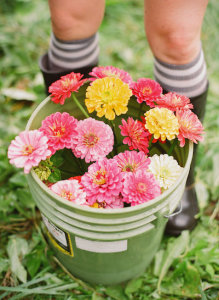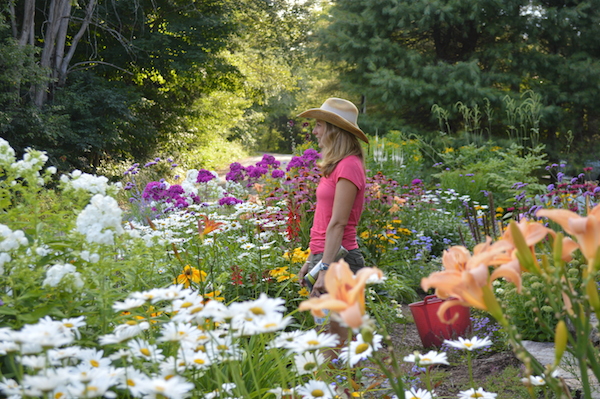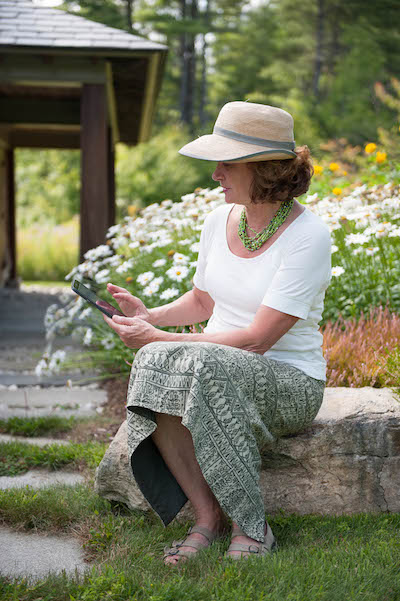In These Shoes? Modish mamas and their sense of cool
By Erica Ludlow Bowman
Few people look to Vermont as a pinnacle of fashion. Fewer yet consider the rubber boot to be a necessary accessory. That is not to say Vermonters don’t have style. We do. It’s a little something called “Vermont chic.” Hard to define perhaps, but as it’s often said, “You know it when you see it.”
Shoes are a big part of the equation. When you have a whole season dedicated to mud and another one dedicated to snow, you simply have to be sensible. Needless to say, muck boots are holding their own and leading the trend are our sweet and sassy lady gardeners. Hip, gritty, and down-to-the-earth these Green Mountain gardenistas have brought style to the manure pile.
Wondering where these trendsetters got their unflappable sense of cool? We located a few of these modish mamas in the field, farm, and garden to learn a little more about their dapper ways, and perhaps even a little about their boots.
Anna of Anna’s Blooms
Her muck boots speak of a necessary practicality. The knee-high socks, feisty short-shorts, and mint-green, 1967 International Scout, those are pure panache. Floral designer, Anna Johansen knows that it pays to express a bit of éclat. There is a fashion to flowers and to succeed, she must capture the mood of the moment.
As owner of the cut-flower company, Anna’s blooms, Johansen has observed that flower fads shift with the season, colors come in and out of style, and people are definitely fickle when it comes to favorites. Market trends are constantly shifting.
Gladiolas, for instance, are “out of vogue,” Johansen explains, “they remind people of funerals.”
In other words, it’s no longer profitable to grow them. Consumers also want to wait until late August before purchasing sunflowers, she adds, even though it is possible to get an earlier bloom. On the other hand, a surprise mention in public media might bring hoards to buy an unsuspecting species. Johansen recalls a market rush on arugula following an article in the New York Times that featured the salad green.
Johansen has learned to develop a “creative response” to her clients’ ever-changing needs. Each has specific tastes, house décor, and moments of whimsy. In one interesting case when the client’s interior paint colors were difficult to complement, Johansen used a minimalist, edgy mix of black, green, and white blooms including: black-night pincushion flower, lime-green zinnias, white pom-pom cosmos, and green Bells of Ireland. A far cry from roses and carnations, of course, but that would be the point. Johansen has complete control of what she grows and sells so her creations can always be modish and chic.
Barb of BB’s Gardens
Known around Newfane for her prodigious sack of tools, Barb Barber is nothing if not equipped. She comes from a long line of engineers, tool makers, and gardeners and knows the pragmatic value of an appropriate implement. You’ll likely find her in the garden with her knees clad with pads, a hat covering her platinum locks, and “cobra head” in hand. When it comes to garden essentials, Ms. Barber means business.
Prior to the establishment of BB’s Gardens, her business was civil engineering. Thirty years ago, she gave that up, engaging instead in the pleasurable pursuits of flowers and skiing. She didn’t enter this career shift unprepared, of course. That would be uncharacteristic. Barber had been training to be gardener for much of her life.
On paper you can see that she earned her Master Gardener certification at Penn State, but that’s not where her story begins. Barber was born into a German family of gardeners where she learned the tenets of plant care as a way of living. Her forebears knew how to grow their own food and proffered flowing, naturalized beds of perennials. At an internship at Longwood Gardens, she worked with a Japanese Master Gardener who encouraged her to explore the creative side of the trade. He showed her the “magic of the earth,” and taught her to hear the musical, rhythmic sounds of nature, to appreciate the birds, bees, and insects, and to acknowledge the plants. Back on the practical side of things, he also taught her the art of plant care and, of course, proper use and maintenance of the tools. Clearly, she learned something.
Maisie and Audrey of My Sister’s Garden
When Maisie Kilburn and Audrey Roberts showed up for their photo shoot wearing the same color shirt, they claimed it was coincidence. The two stood laughing, festooned in the unlikely color of baby blue. Around them the fall flowers raged like a riot. It was a happy, sisterly scene.
Maisie’s gardens have always been wild and beautiful, though she modestly claims that she’s “not a designer.” What she does confess is a fervent love for plants, a predilection she shares with her sister. Audrey learned a lot about gardening from reading books, Maisie explained, but in Maisie’s own gardens it has been trial, error, and a whole lot of work.
Right on route 30 and easily visible to any passer-by, people began to take notice of Maisie’s planting beds before the nursery even existed. Some requested divisions so she began the informal business of digging and selling plants for $3.00 a pot. She left the plants on the porch and people left their money in a jar, just like a farm-stand.
Soon Sister Audrey got in on the action. She brought her divisions from her garden up on Stratton. They sold them together at weekend tag sales. When people had questions about the plants, inevitably it seemed that the wrong sister would be asked. The answer was always the same.
“That’s from my sister’s garden.”
Thus a nursery name was born.
Nancy of Hemlock Hill Landscaping
To look at her in that cowboy hat and candy-pink tee one might think that Nancy Brown is an all-American garden girl. Midwestern maybe, some might think she’d make a pretty convincing Minnesotan; a Wisconsinite at worst.
As it turns out, you can’t tell this book by her cover. Brown lived the first six years of her life in Zell am Zee, Austria. Her father, an Austrian Junior Olympic ski racer, had been recruited by Stratton ski school director, Emo Heinrick to bring the mountain more of an Austrian flair. There he met her mother, an American, who had been living in Winhall on the family’s 100-acre, ancestral farm. The two married, returned to Austria, began a family, and Brown (née Liher) was born.
Brown’s memories of her early Austrian life revolve around the gardens she knew. Her mother and neighboring aunt had lovely plots with the traditional roses, delphiniums, foxgloves, lady’s mantle and the cottage-garden-like. After her move to Vermont, she recalls that her grandmother kept vegetables and perennials while an uncle experimented with new species of potentially hardy California conifers. Brown fondly recollects barefoot summers filled with hayfields and horses, the digging of tree holes, and the picking of potato beetles. She was always an outside child. Visually inspired and kinesthetically gifted, she was a gardener in the making.
She never went to school to study the trade, but she received ample training none-the-less. After working for Rugg Valley Landscaping for five years, Brown developed a mentoring relationship with good friend and gardener, Francine Provost. Under Provost’s tutelage, Brown learned to expand upon the cottage garden concepts of her mind’s eye. Now grown with her own children, she co-owns a business with her husband, Joshua called Hemlock Hill Landscaping.
As for the hat, she says it’s for sun protection more than any statement of style. Though truth be known, she is a devout horse-woman. According to Brown, she’s dreamt of horses from the beginning of time… well horses and flowers.
Julie of JMMDS
As her portrait would attest, Julie Moir Messervy brings technology and a touch of grace to the living landscape. A garden writer and designer for over thirty years, she has created public and private landscapes around North America (including the award-winning Toronto Music Garden with eminent cellist Yo-Yo Ma). Over the years she has developed a sophisticated sense of the industry’s trends. With an eye to the digital age she, along with her team at JMMDS, has developed a garden design app called Home Outside™ Palette. With it, people can use their tablets to develop their own landscape plan in their own backyard.
The hand-drawn app includes all the elements a homeowner might need to create a master plan for their property, allowing the user to create a beautiful drawing with nothing more than the swipe of a finger. The ease and fun of using this tool helps remove some of the psychological barriers in the creation of inspired design.
Messervy has always been interested in making good design accessible to the average homeowner. In her most recent book, “Landscaping Ideas that Work,” she offers a multitude of examples of affordable landscape improvements of varying intensities. As a practiced lecturer and workshop leader, she often addresses large audiences, many of whom are do-it-yourselfers. She hopes that “by making landscape design fun, affordable, and achievable, she can help get everyone outside again.”


























































